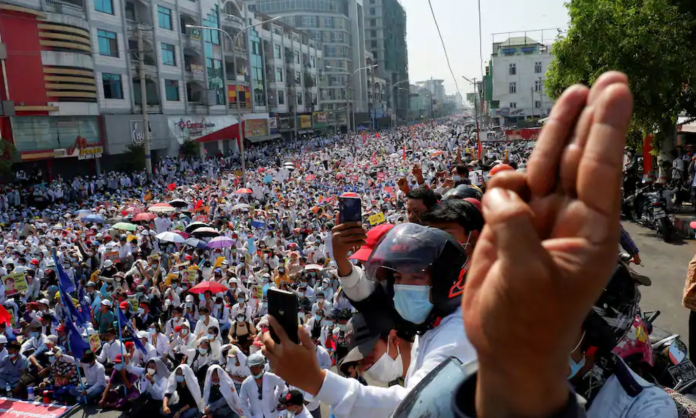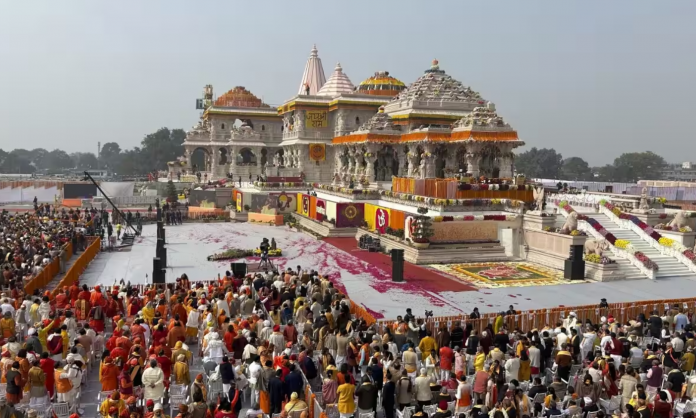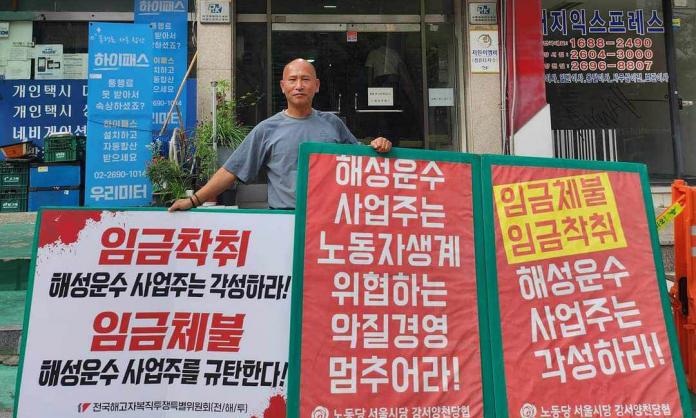Strikes and demonstrations have engulfed Myanmar, after the Tatmadaw (Myanmar’s military) arrested State Counsellor Aung San Suu Kyi and seized government on 1 February. Initiated by health workers and students, the civil disobedience movement (CDM) has mobilised masses of people in street demonstrations that have defied the new junta.
Strikes have paralysed sections of the state bureaucracy, including the ministries of investment and transport, the tax office and the General Administrative Department, which oversees a range of public services and government functions. (Three-quarters of Myanmar’s civil servants are now reportedly on strike.) Entire industries—such as private banking—have been shut down, and a growing number of state-run bank workers are now joining the strikes.
An estimated 60 percent of state electricity workers have gone on strike. Several power departments in Yangon, the country’s largest city, said in Facebook posts that they are refusing to follow orders from the military to cut power during night-time raids. “Our duty is to give electricity, not to cut it”, reads one post.
State railway workers have also gone on strike, refusing to transport soldiers to be used as strikebreakers. For an entire week, the rail networks in Yangon and Mandalay, in the centre of the country, were shut down. In response, riot police were deployed into the housing compounds of train drivers but were beaten back by crowds of angry students and workers.
In working-class districts across Yangon and Mandalay, locals have set up “night patrols” to protect themselves from armed thugs who have been working alongside security forces. Before the night patrols begin, residents bang pots and pans—a household tradition in Myanmar to ward off “evil spirits”—and then sing the protest anthem “Kabar Ma Kyay Bu” (“Until the end of the world”), its lyrics promising a never-ending struggle against the military:
We will be holding a grudge until the end of the world
History is written with our blood
Revolution!
Those who lost their lives in the fight for democracy
Our country is a land built with martyrs
We will be holding a grudge until the end of the world
The Tatmadaw have ruled Myanmar for most of the country’s modern history. After gaining independence from British rule in 1947, the country underwent a period of rapid industrial development—accompanied by rising labour militancy—before the Tatmadaw, fearful of the threat posed by an insurgent working-class movement, seized power in 1962.
The Tatmadaw ruled for the next two decades through an authoritarian state capitalist regime that crushed all independent arms of the workers’ movement. But in August 1988, the regime was rocked by student demonstrations and strikes demanding democracy. Aung San Suu Kyi, the daughter of Aung San, the military leader who led the movement for independence from British rule, put herself at the head of the movement, redirecting it away from confrontation with the regime. The Tatmadaw regained control of the situation, massacring thousands of civilians, and cremated protest leaders while they were still alive. Many of those who escaped such a fate, including Suu Kyi, were later thrown into jail or put under house arrest.
Since the 1990s, the Tatmadaw has consolidated its position as a central fraction of Myanmar’s capitalist class. Through two military-owned conglomerates—Myanmar Economic Corporation and Myanmar Economic Holding Ltd.—the Tatmadaw used privatisations to seize control of former state-run companies at fire-sale prices. These conglomerates control businesses and investments in sectors ranging from beer, tobacco and consumables to mines, mills, tourism, property development and communications.
The Tatmadaw drew up the 2008 constitution to ensure that it continued to hold key levers of power. A quarter of seats in both parliamentary houses are reserved for military appointees, ensuring that it can block any constitutional amendment. The Tatmadaw also remains in control of powerful ministries, including defence and home affairs, and is thus excluded from any civilian oversight. Suu Kyi, who was freed from house arrest in 2010, and her National Democratic League (NLD) have agreed to maintain this arrangement despite the military formally allowing civilian rule a decade ago.
Since then, Myanmar has become home to large investments from East and South-East Asian capitalists—primarily from China, Thailand, Singapore and Japan—in garment manufacturing, agribusiness, mining and oil. The result has been widespread land dispossession in rural areas, which has underpinned the expansion of low-wage, informal, precarious employment in rapidly developing urban centres. (According to Myanmar’s Department of Labour, 83 percent of the workforce is now engaged in the informal sector.) In recent years, it has also resulted in a wave of strikes and labour organising in the female-dominated garment industry.
In power, the NLD and its allies in the Tatmadaw tried to redirect class anger over economic issues by stoking ethnic nationalism. Rohingya Muslims from the Rakhine state became a particular target of the Suu Kyi regime, culminating in 2017 in a campaign of forced transfers that included military rape, murder and the torching of homes. Hundreds of thousands of Rohingya were driven out of Myanmar into neighbouring Bangladesh and are yet to return.
During NLD rule, the Tatmadaw believed that it could advance its position though an electoral vehicle, the Union Solidarity and Development Party. But the USDP has proven an abject failure in electoral terms, completely overshadowed at the polls by the NLD, which won overwhelming parliamentary majorities in both the 2015 and 2020 elections.
Combined with a general decline in the economic climate, intensified by the onset of COVID-19, the Tatmadaw’s decision to seize power is due to the breakdown of the conditions that have maintained a balance between civilian and military rule. But these conditions have also raised the expectations of an entire generation that has now lived without open military dictatorship. The result has been the explosion of strikes and demonstrations now engulfing the entire country.
In response to the growing movement, the Tatmadaw has used fierce repression—including tear gas, water cannons, telecommunications and electricity shutdowns, night-time curfews and mass arrests—in efforts to intimidate protesters and detain strike leaders. (According to the Assistance Association for Political Prisoners, more than 700 people have been arrested since 1 February.) Many workers in strategically important industries, such as state-run banks, power stations, transport and telecommunications, are being forced to work at gunpoint.
The Tatmadaw has also used lethal force. In Naypyidaw, the capital, 20-year-old student Mya Thwet Thwet Khine died in hospital after being shot in the head by police. In Yangon’s Shew Pyithar township, Ko Tin Htut Hein, a 30-year-old member of a civilian night patrol, was gunned down by police in a civilian van. And in Mandalay, 16-year-old Wai Yan Tun and 37-year-old Ko Min Min Min Ko were killed, and another 30 people injured, when riot police opened fire with live ammunition on local residents protecting striking shipyard workers.
Intensified repression has only galvanised the movement. On 20 February, a “general strike committee” was formed, bringing together political parties, labour, student and farmers’ unions, women’s groups, religious groups, monks, doctors, lawyers and writers groups which, alongside the formation of local strike committees, is aiming to end military rule, free all political prisoners, abolish the 2008 constitution and establish a federal democratic union (one that would grant all ethnic minorities, including the Rohingya, political rights). In an official statement, the strike committee said: “We cannot collapse. If we draw back now, the military regime will intensify its crackdown. Therefore, it is important to unite between organisations and intensify the strike”.
On 22 February, more than one million people joined the call for a general strike and marched in the largest nationwide mobilisation since resistance to the coup began. In Yangon, hundreds of thousands of demonstrators descended upon Sule Pagoda Road, Hledan Junction and Myaynigone, reclaiming these gathering points after they had been barricaded with barbed wire and filled with riot police the preceding weekend. In Mandalay, tens of thousands of demonstrators shut down the central business district, making it impossible for the police and armed forces to carry out repression.
The creation of strike committees provides an alternative source of power to the Tatmadaw through which the movement can coordinate itself on a national scale. But to truly challenge the Tatmadaw’s economic and political power, the strike committees will need to become rooted in workplaces under the leadership of striking workers. In the coming days and weeks, the ability of Myanmar’s powerful working class to impose its will on the situation—through more strikes that paralyse the economy—will be crucial.











